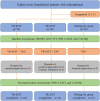Virtual-reality-based social cognition and interaction training for patients with schizophrenia: A preliminary efficacy study
- PMID: 36465308
- PMCID: PMC9714325
- DOI: 10.3389/fpsyt.2022.1022278
Virtual-reality-based social cognition and interaction training for patients with schizophrenia: A preliminary efficacy study
Abstract
Background: Social cognition and interaction training (SCIT) is a psychosocial intervention program for patients with psychosis, designed to improve their social functioning by improving social cognition. Although the feasibility and efficacy of SCIT have been verified, patients with schizophrenia tend to suffer from motivational deficits and low treatment adherence. It has been suggested that using virtual reality (VR) technology might be effective in addressing these issues. In this study, we aimed to develop a VR-based SCIT and compare its efficacy with that of traditional SCIT.
Materials and methods: We developed a novel VR-based social cognition and interaction training (VR-SCIT) that combines traditional SCIT (TR-SCIT) intervention with VR technology. Participants were randomly assigned in a 1:1:1 ratio to the VR-SCIT (n = 28), TR-SCIT (n = 30), or waiting-list groups (n = 29). All treatments were combined with treatment-as-usual. Assessments of social cognition (i.e., Chinese version of Face-Affective Identification Task, Chinese version of Social Cognition Screening Questionnaire) and social functioning (i.e., Chinese version of Personal and Social Performance Scale) were administered from baseline to post-intervention.
Results: Patients receiving VR-SCIT and TR-SCIT showed a significantly greater improvement on the assessments of emotion perception (Cohen's d was 1.66, 0.55, and 0.10 for VR-SCIT, TR-SCIT, and Waiting-list, respectively), hostile attributional bias (Cohen's d was 0.48, 0.44, and 0.05 for VR-SCIT, TR-SCIT, and Waiting-list, respectively), metacognition (Cohen's d was 1.66, 0.76, and 0.06 for VR-SCIT, TR-SCIT, and waiting-list, respectively), and social functioning (Cohen's d was 1.09, 0.90, and 0.20 for VR-SCIT, TR-SCIT, and waiting-list, respectively) from baseline to post-intervention, compared to those in waiting-list group. Additionally, VR-SCIT showed an advantage over TR-SCIT in improving emotion perception and metacognition with higher treatment compliance.
Conclusion: These preliminary findings indicate that VR-SCIT is a feasible and promising method for improving social cognition and social functioning in patients with schizophrenia.
Keywords: psychosis; schizophrenia; social cognition; social cognition and interaction training; social functioning; virtual reality.
Copyright © 2022 Shen, Liu, Wu, Lin and Wang.
Conflict of interest statement
The authors declare that the research was conducted in the absence of any commercial or financial relationships that could be construed as a potential conflict of interest.
Figures


Similar articles
-
Social cognition and interaction training for patients with stable schizophrenia in Chinese community settings.Psychiatry Res. 2013 Dec 30;210(3):751-5. doi: 10.1016/j.psychres.2013.08.038. Epub 2013 Sep 6. Psychiatry Res. 2013. PMID: 24018268 Clinical Trial.
-
Social Cognition and Interaction Training (SCIT) versus Training in Affect Recognition (TAR) in patients with schizophrenia: A randomized controlled trial.J Psychiatr Res. 2021 Oct;142:101-109. doi: 10.1016/j.jpsychires.2021.07.029. Epub 2021 Jul 23. J Psychiatr Res. 2021. PMID: 34332374 Clinical Trial.
-
A randomized waitlist control community study of Social Cognition and Interaction Training for people with schizophrenia.Br J Clin Psychol. 2018 Mar;57(1):116-130. doi: 10.1111/bjc.12161. Epub 2017 Oct 9. Br J Clin Psychol. 2018. PMID: 28990190 Clinical Trial.
-
Feasibility and Efficacy of Virtual Reality Interventions to Improve Psychosocial Functioning in Psychosis: Systematic Review.JMIR Ment Health. 2022 Feb 18;9(2):e28502. doi: 10.2196/28502. JMIR Ment Health. 2022. PMID: 35179501 Free PMC article. Review.
-
Examining the effect of virtual reality therapy on cognition post-stroke: a systematic review and meta-analysis.Disabil Rehabil Assist Technol. 2022 Jan;17(1):50-60. doi: 10.1080/17483107.2020.1755376. Epub 2020 May 2. Disabil Rehabil Assist Technol. 2022. PMID: 32363955
Cited by
-
Treatment of cognitive deficits in schizophrenia using a new technique of Cognitive Training in Virtual Reality: a pilot study.Health Psychol Res. 2025 Mar 23;13:129550. doi: 10.52965/001c.129550. eCollection 2025. Health Psychol Res. 2025. PMID: 40134516 Free PMC article.
-
Efficacy of social cognition and interaction training in outpatients with schizophrenia spectrum disorders: randomized controlled trial.Front Psychiatry. 2023 Aug 4;14:1217735. doi: 10.3389/fpsyt.2023.1217735. eCollection 2023. Front Psychiatry. 2023. PMID: 37599886 Free PMC article.
-
Digital therapeutics for cognitive impairments associated with schizophrenia: our opinion.Front Psychiatry. 2025 Apr 17;16:1535309. doi: 10.3389/fpsyt.2025.1535309. eCollection 2025. Front Psychiatry. 2025. PMID: 40313239 Free PMC article. No abstract available.
-
Beyond memory: exploring the value of social cognition for older adults with neurocognitive disorders.Front Psychiatry. 2023 Sep 28;14:1209745. doi: 10.3389/fpsyt.2023.1209745. eCollection 2023. Front Psychiatry. 2023. PMID: 37840782 Free PMC article.
-
[Digital interventions for psychoses: current opportunities and challenges].Nervenarzt. 2025 Sep;96(5):439-444. doi: 10.1007/s00115-025-01883-x. Epub 2025 Aug 11. Nervenarzt. 2025. PMID: 40788364 Free PMC article. Review. German.
References
LinkOut - more resources
Full Text Sources

